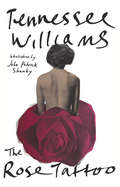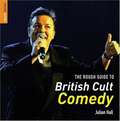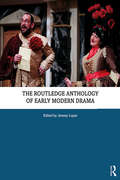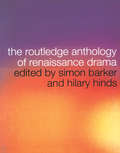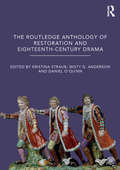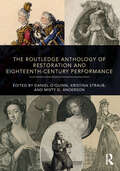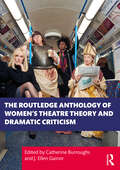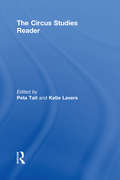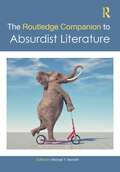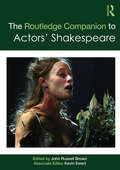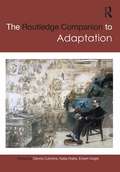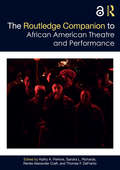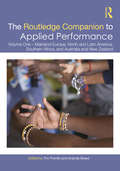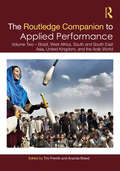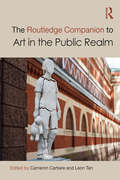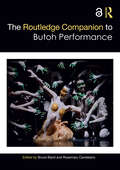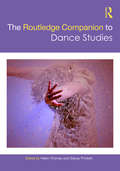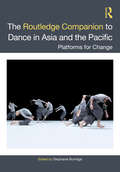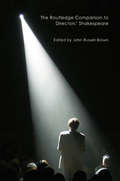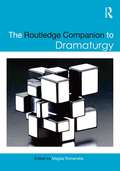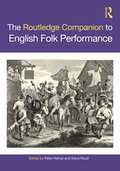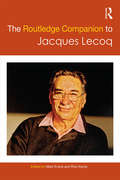- Table View
- List View
The Rose Tattoo
by John Patrick Shanley Tennessee Williams Jack BarberaPublished as a trade paperback for the first time, with a new introduction by the acclaimed playwright John Patrick Shanley (Doubt) and the one-act on which The Rose Tattoo was based. The Rose Tattoo is larger than life--a fable, a Greek tragedy, a comedy, a melodrama--it is a love letter from Tennessee Williams to anyone who has ever been in love or ever will be. Professional widow and dressmaker Serafina delle Rosa has withdrawn from the world, locking away her heart and her sixteen-year-old daughter Rosa. Then one day a man with the sexy body of her late Sicilian husband and the face of a village idiot, Mangiacavallo (Italian for "eat a horse"), stumbles into her life and clumsily unlocks Serafina's fiery anger, sense of betrayal, pride, wit, passion, and eventually her capacious love. The original production of The Rose Tattoo won Tony Awards for best play and for the stars, Eli Wallach and Maureen Stapleton. Anna Magnani received the Academy Award as Best Actress for the 1955 film version. This edition of The Rose Tattoo has an Introduction by playwright John Patrick Shanley, the author's original foreword, the one-act The Dog Enchanted by the Divine View that was the germ for the play, and an essay by noted Tennessee Williams scholar Jack Barbera.
The Rough Guide to British Cult Comedy
by Julian HallThe British Cult Comedy is the guide to live and television comedy in Britain from the 1980s to the present day. From Ben Elton to Alan Carr, this book profiles fifty of the influential cult comedy icons and discovers how they became household names.
The Routledge Anthology of British Women Playwrights, 1777-1843
by Thomas C. Crochunis Michael E. SinatraThe Routledge Anthology of British Women Playwrights, 1777-1843 brings together ten eclectic plays by female dramatists and writers, to stimulate a rich discussion of women, writing, and theatre history. Ranging through tragedy, comedy, musical theatre and mixed-genre texts, this volume celebrates the breadth and experimental spirit of women's eighteenth- and nineteenth-century dramatic writing. Each play is accompanied by an introductory essay that addresses its sociopolitical and theatrical contexts, and outlines its performance and reception history. The selections included here invite teachers and their students to study particular works by authors of note, but also to consider the differences between works written for page and stage. While many of the plays are recognizable as published dramas, they have been placed alongside textual artifacts that suggest plays or theatrical events of which no definitive record exists, as well as supplementary materials that invite teachers to engage their students in exploring women's dramatic writing in this era. Organized in chronological order, The Routledge Anthology of British Women Playwrights, 1777-1843 traces a history of women's writing across genres and styles, offering an invaluable resource to students and teachers alike.
The Routledge Anthology of Early Modern Drama
by Jeremy LopezThe Routledge Anthology of Early Modern Drama is the first new collection of the drama of Shakespeare’s contemporaries in over a century.This volume comprises seventeen accessible, thoroughly glossed, modernized play-texts, intermingling a wide range of unfamiliar works—including the anonymous Look About You, Massinger’s The Picture, Heminge’s The Fatal Contract, Heywood’s The Four Prentices of London, and Greene’s James IV—with more familiar works such as Marlowe’s Doctor Faustus, Webster’s The Duchess of Malfi, and Middleton’s Women Beware Women. Each play is edited by a different leading scholar in the field of early modern studies, bringing specific expertise and context to the chosen play-text.With an unprecedented variety of plays, and critical introductions that focus on the diversity and strangeness of different early modern approaches to the artistic and commercial enterprise of play-making, The Routledge Anthology of Early Modern Drama will offer vital new perspectives on early modern drama for scholars, students, and performers alike.
The Routledge Anthology of Renaissance Drama
by Hilary Hinds Simon BarkerThis anthology offers a full introduction to Renaissance theatre in its historical and political context, along with newly edited and thoroughly annotated texts of the following plays:* The Spanish Tragedy (Thomas Kyd)* Arden of Faversham (Anon.)* Edward II (Christopher Marlowe)* A Woman Killed with Kindness (Thomas Heywood)* The Tragedy of Mariam (Elizabeth Cary)* The Masque of Blackness (Ben Jonson)* The Knight of the Burning Pestle (Francis Beaumont)* Epicoene, or the Silent Woman (Ben Jonson)* The Roaring Girl (Thomas Middleton & Thomas Dekker)* The Changeling (Thomas Middleton & William Rowley)* 'Tis Pity She's a Whore (John Ford).Each play is prefaced by an introductory headnote discussing the thematic focus of the play and its textual history, and is cross-referenced to other plays of the period that relate thematically and generically.An accompanying website contains a wide selection of contextual documents which supplement the anthology: www.routledge.com/textbooks/0415187346
The Routledge Anthology of Restoration and Eighteenth-Century Drama
by Kristina Straub, Misty Anderson, and Daniel O’QuinnThe Routledge Anthology of Restoration and Eighteenth-Century Drama brings together the work of key playwrights from 1660 to 1800, divided into three main sections: Restoring the Theatre: 1660–1700 Managing Entertainment: 1700–1760 Entertainment in an Age of Revolutions: 1760–1800 Each of the 20 plays featured is accompanied by an extraordinary wealth of print and online supplementary materials, including primary critical sources, commentaries, illustrations, and reviews of productions. Taking in the spectrum of this period’s dramatic landscape—from Restoration tragedy and comedies of manners to ballad opera and gothic spectacle—The Routledge Anthology of Restoration and Eighteenth-Century Drama is an essential resource for students and teachers alike.
The Routledge Anthology of Restoration and Eighteenth-Century Performance
by Kristina Straub Misty G. Anderson Daniel O’QuinnThe Routledge Anthology of Restoration and Eighteenth-Century Performance brings together a selection of particularly memorable performances, beginning with Nell Gwyn in a 1668 staging of Secret Love, and moving chronologically towards the final performance of John Philip Kemble's controversial adaptation of Thomas Otway's Venice Presever'd in October 1795. This volume contains a wealth of contextual materials, including contemporary reviews, portraits, advertisements, and cast lists. By privileging event over publication, this collection aims to encourage an understanding of performance that emphasizes the immediacy - and changeability - of the theatrical repertoire during the long eighteenth century. Offering an invaluable insight into the performance culture of the time, The Routledge Anthology of Restoration and Eighteenth-Century Performance is a unique, much-needed resource for students of theatre.
The Routledge Anthology of Women's Theatre Theory and Dramatic Criticism
by J. Ellen Gainor Catherine BurroughsThe Routledge Anthology of Women's Theatre Theory and Dramatic Criticism is the first wide-ranging anthology of theatre theory and dramatic criticism by women writers. Reproducing key primary documents contextualized by short essays, the collection situates women’s writing within, and also reframes the field’s male-defined and male-dominated traditions. Its collection of documents demonstrates women’s consistent and wide-ranging engagement with writing about theatre and performance and offers a more expansive understanding of the forms and locations of such theoretical and critical writing, dealing with materials that often lie outside established production and publication venues. This alternative tradition of theatre writing that emerges allows contemporary readers to form new ways of conceptualizing the field, bringing to the fore a long-neglected, vibrant, intelligent, deeply informed, and expanded canon that generates a new era of scholarship, learning, and artistry. The Routledge Anthology of Women's Theatrical Theory and Dramatic Criticism is an important intervention into the fields of Theatre and Performance Studies, Literary Studies, and Cultural History, while adding new dimensions to Feminist, Gender and Sexuality Studies.
The Routledge Circus Studies Reader
by Peta Tait and Katie LaversThe Routledge Circus Studies Reader offers an absorbing critical introduction to this diverse and emerging field. It brings together the work of over 30 scholars in this discipline, including Janet Davis, Helen Stoddart and Peta Tait, to highlight and address the field’s key historical, critical and theoretical issues. It is organised into three accessible sections, Perspectives, Precedents and Presents, which approach historical aspects, current issues, and the future of circus performance. The chapters, grouped together into 13 theme-based sub-sections, provide a clear entry point into the field and emphasise the diversity of approaches available to students and scholars of circus studies. Classic accounts of performance, including pieces by Philippe Petit and Friedrich Nietzsche, are included alongside more recent scholarship in the field. Edited by two scholars whose work is strongly connected to the dynamic world of performance, The Routledge Circus Studies Reader is an essential teaching and study resource for the emerging discipline of circus studies. It also provides a stimulating introduction to the field for lovers of circus.
The Routledge Companion to Absurdist Literature (Routledge Literature Companions)
by Michael Y. BennettThe Routledge Companion to Absurdist Literature is the first authoritative and definitive edited collection on absurdist literature. As a field-defining volume, the editor and the contributors are world leaders in this ever-exciting genre that includes some of the most important and influential writers of the twentieth century, including Samuel Beckett, Harold Pinter, Edward Albee, Eugene Ionesco, Jean Genet, and Albert Camus. Ever puzzling and always refusing to be pinned down, this book does not attempt to define absurdist literature, but attempts to examine its major and minor players. As such, the field is indirectly defined by examining its constituent writers. Not only investigating the so-called “Theatre of the Absurd,” this volume wades deeply into absurdist fiction and absurdist poetry, expanding much of our previous sense of what constitutes absurdist literature. Furthermore, long overdue, approximately one-third of the book is devoted to marginalized writers: black, Latin/x, female, LGBTQ+, and non-Western voices.
The Routledge Companion to Actors' Shakespeare (Routledge Companions)
by John Russell BrownThe Routledge Companion to Actors’ Shakespeare is a window onto how today’s actors contribute to the continuing life and relevance of Shakespeare’s plays. The process of acting is notoriously hard to document, but this volume reaches behind famous performances to examine the actors’ craft, their development and how they engage with playtexts. Each chapter relies upon privilieged access to its subject to offer an unparalleled insight into contemporary practice. This volume explores the techniques, interpretive approaches and performance styles of the following actors: Simon Russell Beale, Sinead Cusack, Judi Dench, Kate Duchene, Colm Feore, Mariah Gale, John Harrell, Greg Hicks, Rory Kinnear, Kevin Kline, Adrian Lester, Marcelo Magni, Ian McKellen, Patrice Naiambana, Vanessa Redgrave, Piotr Semak, Anthony Sher, Jonathan Slinger, Kate Valk, Harriet Walter This twin volume to The Routledge Companion to Directors’ Shakespeare is an essential work for both actors and students of Shakespeare.
The Routledge Companion to Adaptation (Routledge Companions)
by Dennis Cutchins Katja Krebs Eckart VoigtsThe Routledge Companion to Adaptation offers a broad range of scholarship from this growing, interdisciplinary field. With a basis in source-oriented studies, such as novel-to-stage and stage-to-film adaptations, this volume also seeks to highlight the new and innovative aspects of adaptation studies, ranging from theatre and dance to radio, television and new media. It is divided into five sections: Mapping, which presents a variety of perspectives on the scope and development of adaptation studies; Historiography, which investigates the ways in which adaptation engages with – and disrupts – history; Identity, which considers texts and practices in adaptation as sites of multiple and fluid identity formations; Reception, which examines the role played by an audience, considering the unpredictable relationships between adaptations and those who experience them; Technology, which focuses on the effects of ongoing technological advances and shifts on specific adaptations, and on the wider field of adaptation. An emphasis on adaptation-as-practice establishes methods of investigation that move beyond a purely comparative case study model. The Routledge Companion to Adaptation celebrates the complexity and diversity of adaptation studies, mapping the field across genres and disciplines.
The Routledge Companion to African American Theatre and Performance (Routledge Companions)
by Kathy A. Perkins Sandra L. Richards Renée Alexander Craft Thomas F. DeFrantzThe Routledge Companion to African American Theatre and Performance is an outstanding collection of specially written essays that charts the emergence, development, and diversity of African American Theatre and Performance—from the nineteenth-century African Grove Theatre to Afrofuturism. Alongside chapters from scholars are contributions from theatre makers, including producers, theatre managers, choreographers, directors, designers, and critics. This ambitious Companion includes: A "Timeline of African American theatre and performance." Part I "Seeing ourselves onstage" explores the important experience of Black theatrical self-representation. Analyses of diverse topics including historical dramas, Broadway musicals, and experimental theatre allow readers to discover expansive articulations of Blackness. Part II "Institution building" highlights institutions that have nurtured Black people both on stage and behind the scenes. Topics include Historically Black Colleges and Universities (HBCUs), festivals, and black actor training. Part III "Theatre and social change" surveys key moments when Black people harnessed the power of theatre to affirm community realities and posit new representations for themselves and the nation as a whole. Topics include Du Bois and African Muslims, women of the Black Arts Movement, Afro-Latinx theatre, youth theatre, and operatic sustenance for an Afro future. Part IV "Expanding the traditional stage" examines Black performance traditions that privilege Black worldviews, sense-making, rituals, and innovation in everyday life. This section explores performances that prefer the space of the kitchen, classroom, club, or field. This book engages a wide audience of scholars, students, and theatre practitioners with its unprecedented breadth. More than anything, these invaluable insights not only offer a window onto the processes of producing work, but also the labour and economic issues that have shaped and enabled African American theatre.
The Routledge Companion to Applied Performance: Volume One – Mainland Europe, North and Latin America, Southern Africa, and Australia and New Zealand (Routledge Companions)
by Tim Prentki and Ananda BreedThe Routledge Companion to Applied Performance provides an in-depth, far-reaching and provocative consideration of how scholars and artists negotiate the theoretical, historical and practical politics of applied performance, both in the academy and beyond. These volumes offer insights from within and beyond the sphere of English-speaking scholarship, curated by regional experts in applied performance. The reader will gain an understanding of some of the dominant preoccupations of performance in specified regions, enhanced by contextual framing. From the dis(h)arming of the human body through dance in Colombia to clowning with dementia in Australia, via challenges to violent nationalism in the Balkans, transgender performance in Pakistan and resistance rap in Kashmir, the essays, interviews and scripts are eloquent testimony to the courage and hope of people who believe in the power of art to renew the human spirit. Students, academics, practitioners, policy-makers, cultural anthropologists and activists will benefit from the opportunities to forge new networks and develop in-depth comparative research offered by this bold, global project.
The Routledge Companion to Applied Performance: Volume Two – Brazil, West Africa, South and South East Asia, United Kingdom, and the Arab World (Routledge Companions)
by Tim Prentki and Ananda BreedThe Routledge Companion to Applied Performance provides an in-depth, far-reaching and provocative consideration of how scholars and artists negotiate the theoretical, historical and practical politics of applied performance, both in the academy and beyond. These volumes offer insights from within and beyond the sphere of English-speaking scholarship, curated by regional experts in applied performance. The reader will gain an understanding of some of the dominant preoccupations of performance in specified regions, enhanced by contextual framing. From the dis(h)arming of the human body through dance in Colombia to clowning with dementia in Australia, via challenges to violent nationalism in the Balkans, transgender performance in Pakistan and resistance rap in Kashmir, the essays, interviews and scripts are eloquent testimony to the courage and hope of people who believe in the power of art to renew the human spirit. Students, academics, practitioners, policy-makers, cultural anthropologists and activists will benefit from the opportunities to forge new networks and develop in-depth comparative research offered by this bold, global project.
The Routledge Companion to Art in the Public Realm (Routledge Art History and Visual Studies Companions)
by Cameron CartiereThis multidisciplinary companion offers a comprehensive overview of the global arena of public art. It is organised around four distinct topics: activation, social justice, memory and identity, and ecology, with a final chapter mapping significant works of public and social practice art around the world between 2008 and 2018. The thematic approach brings into view similarities and differences in the recent globalisation of public art practices, while the multidisciplinary emphasis allows for a consideration of the complex outcomes and consequences of such practices, as they engage different disciplines and communities and affect a diversity of audiences beyond the existing 'art world'. The book will highlight an international selection of artist projects that illustrate the themes. This book will be of interest to scholars in contemporary art, art history, urban studies, and museum studies.
The Routledge Companion to Art in the Public Realm (Routledge Art History and Visual Studies Companions)
by Cameron CartiereThis multidisciplinary companion offers a comprehensive overview of the global arena of public art.It is organised around four distinct topics: activation, social justice, memory and identity, and ecology, with a final chapter mapping significant works of public and social practice art around the world between 2008 and 2018. The thematic approach brings into view similarities and differences in the recent globalisation of public art practices, while the multidisciplinary emphasis allows for a consideration of the complex outcomes and consequences of such practices, as they engage different disciplines and communities and affect a diversity of audiences beyond the existing 'art world'. The book will highlight an international selection of artist projects that illustrate the themes.This book will be of interest to scholars in contemporary art, art history, urban studies, and museum studies.
The Routledge Companion to Butoh Performance (Routledge Companions)
by Rosemary Candelario Bruce BairdThe Routledge Companion to Butoh Performance provides a comprehensive introduction to and analysis of the global art form butoh. Originating in Japan in the 1960s, butoh was a major innovation in twentieth century dance and performance, and it continues to shape-shift around the world. Taking inspiration from the Japanese avant-garde, Surrealism, Happenings, and authors such as Genet and Artaud, its influence can be seen throughout contemporary performing arts, music, and visual art practices. This Companion places the form in historical context, documents its development in Japan and its spread around the world, and brings together the theory and the practice of this compelling dance. The interdisciplinarity evident in the volume reflects the depth and the breadth of butoh, and the editors bring specially commissioned essays by leading scholars and dancers together with translations of important early texts.
The Routledge Companion to Butoh Performance (Routledge Companions)
by Rosemary Candelario Bruce BairdThe Routledge Companion to Butoh Performance provides a comprehensive introduction to and analysis of the global art form butoh.Originating in Japan in the 1960s, butoh was a major innovation in twentieth century dance and performance, and it continues to shape-shift around the world. Taking inspiration from the Japanese avant-garde, Surrealism, Happenings, and authors such as Genet and Artaud, its influence can be seen throughout contemporary performing arts, music, and visual art practices.This Companion places the form in historical context, documents its development in Japan and its spread around the world, and brings together the theory and the practice of this compelling dance. The interdisciplinarity evident in the volume reflects the depth and the breadth of butoh, and the editors bring specially commissioned essays by leading scholars and dancers together with translations of important early texts.The Open Access version of this book, available at http://www.taylorfrancis.com, has been made available under a Creative Commons Attribution (CC-BY) 4.0 license.
The Routledge Companion to Dance Studies (Routledge Companions)
by Helen Thomas Stacey PrickettThe Routledge Companion to Dance Studies maps out the key features of dance studies as the field stands today, while pointing to potential future developments. It locates these features both historically—within dance in particular social and cultural contexts—and in relation to other academic influences that have impinged on dance studies as a discipline. The editors use a thematically based approach that emphasizes that dance scholarship does not stand alone as a single entity, but is inevitably linked to other related fields, debates, and concerns. Authors from across continents have contributed chapters based on theoretical, methodological, ethnographic, and practice-based case studies, bringing together a wealth of expertise and insight to offer a study that is in-depth and wide-ranging. Ideal for scholars and upper-level students of dance and performance studies, The Routledge Companion to Dance Studies challenges the reader to expand their knowledge of this vibrant, exciting interdisciplinary field.
The Routledge Companion to Dance in Asia and the Pacific: Platforms for Change
by Stephanie BurridgeThis Companion documents and celebrates artistic journeys within the framework of rich and complex cultural heritages and traditional dance practices of the Asia-Pacific region. It presents various dance forms from Australia, Cambodia, China, Hong Kong, India, Indonesia, Malaysia, the Philippines, Singapore, Taiwan, Thailand, and the South Pacific. Drawing on extensive research and decades of performative experience as artists, choreographers, producers, teachers, and critics, the authors approach issues of dance and cultural diversity from a theoretical perspective while at the same time exploring change, process, and transformation through dance. The book discusses themes such as tradition, contemporization, interdisciplinarity, dance education, youth dance, dance networks, curatorial practices, and evolving performative practices of dance companies and independents. It also looks at regional networking, curating dance festivals and spaces that foster collaboration, regional cooperation, and cultural exchange, which are essential features of dance in Asia and the Pacific. This collection will be of interest to students and researchers of pedagogy, choreography, community dance practice, theatre and performance studies, social and cultural studies, aesthetics, interdisciplinary arts, and more. It will be an invaluable resource for artists and practitioners working in dance schools and communities.
The Routledge Companion to Directors' Shakespeare (Routledge Companions)
by John Russell BrownThe Routledge Companion to Directors' Shakespeare is a major collaborative book about plays in performance. Thirty authoritative accounts describe in illuminating detail how some of theatre’s most talented directors have brought Shakespeare’s texts to the stage. Each chapter has a revealing story to tell as it explores a new and revitalising approach to the most familiar works in the English language. A must-have work of reference for students of both Shakespeare and theatre, this book presents some of the most acclaimed productions of the last hundred years in a variety of cultural and political contexts. Each entry describes a director’s own theatrical vision, and methods of rehearsal and production. These studies chart the extraordinary feats of interpretation and innovation that have given Shakespeare’s plays enduring life in the theatre. Notable entries include: Ingmar Bergman * Peter Brook * Declan Donnellan * Tyrone Guthrie * Peter Hall * Fritz Kortner * Robert Lepage * Joan Littlewood * Ninagawa Yukio * Joseph Papp * Roger Planchon * Max Reinhardt * Giorgio Strehler * Deborah Warner * Orson Welles * Franco Zeffirelli
The Routledge Companion to Dramaturgy (Routledge Companions)
by Magda RomanskaDramaturgy, in its many forms, is a fundamental and indispensable element of contemporary theatre. In its earliest definition, the word itself means a comprehensive theory of "play making." Although it initially grew out of theatre, contemporary dramaturgy has made enormous advances in recent years, and it now permeates all kinds of narrative forms and structures: from opera to performance art; from dance and multimedia to filmmaking and robotics. In our global, mediated context of multinational group collaborations that dissolve traditional divisions of roles as well as unbend previously intransigent rules of time and space, the dramaturg is also the ultimate globalist: intercultural mediator, information and research manager, media content analyst, interdisciplinary negotiator, social media strategist. This collection focuses on contemporary dramaturgical practice, bringing together contributions not only from academics but also from prominent working dramaturgs. The inclusion of both means a strong level of engagement with current issues in dramaturgy, from the impact of social media to the ongoing centrality of interdisciplinary and intermedial processes. The contributions survey the field through eight main lenses: world dramaturgy and global perspective dramaturgy as function, verb and skill dramaturgical leadership and season planning production dramaturgy in translation adaptation and new play development interdisciplinary dramaturgy play analysis in postdramatic and new media dramaturgy social media and audience outreach. Magda Romanska is Visiting Associate Professor of Slavic Languages and Literatures at Harvard University, Associate Professor of Theatre and Dramaturgy at Emerson College, and Dramaturg for Boston Lyric Opera. Her books include The Post-Traumatic Theatre of Grotowski and Kantor (2012), Boguslaw Schaeffer: An Anthology (2012), and Comedy: An Anthology of Theory and Criticism (2014).
The Routledge Companion to English Folk Performance (Routledge Companions)
by Peter Harrop Steve RoudThis broad-based collection of essays is an introduction both to the concerns of contemporary folklore scholarship and to the variety of forms that folk performance has taken throughout English history. Combining case studies of specific folk practices with discussion of the various different lenses through which they have been viewed since becoming the subject of concerted study in Victorian times, this book builds on the latest work in an ever-growing body of contemporary folklore scholarship. Many of the contributing scholars are also practicing performers and bring experience and understanding of performance to their analyses and critiques. Chapters range across the spectrum of folk song, music, drama and dance, but maintain a focus on the key defining characteristics of folk performance – custom and tradition – in a full range of performances, from carol singing and sword dancing to playground rhymes and mummers' plays. As well as being an essential reference for folklorists and scholars of traditional performance and local history, this is a valuable resource for readers in all disciplines of dance, drama, song and music whose work coincides with English folk traditions.
The Routledge Companion to Jacques Lecoq (Routledge Companions)
by Mark Evans Rick KempThe Routledge Companion to Jacques Lecoq presents a thorough overview and analysis of Jacques Lecoq's life, work and philosophy of theatre. Through an exemplary collection of specially commissioned chapters from leading writers, specialists and practitioners, it draws together writings and reflections on his pedagogy, his practice, and his influence on the wider theatrical environment. It is a comprehensive guide to the work and legacy of one of the major figures of Western theatre in the second half of the twentieth century. In a four-part structure over fifty chapters, the book examines: The historical, artistic and social context out of which Lecoq's work and pedagogy arose, and its relation to such figures as Jacques Copeau, Antonin Artaud, Jean-Louis Barrault, and Dario Fo. Core themes of Lecoq's International School of Theatre, such as movement, play, improvisation, masks, language, comedy, and tragedy, investigated by former teachers and graduates of the School. The significance and value of his pedagogical approaches in the context of contemporary theatre practices. The diaspora of performance practice from the School, from the perspective of many of the most prominent artists themselves. This is an important and authoritative guide for anyone interested in Lecoq's work.
